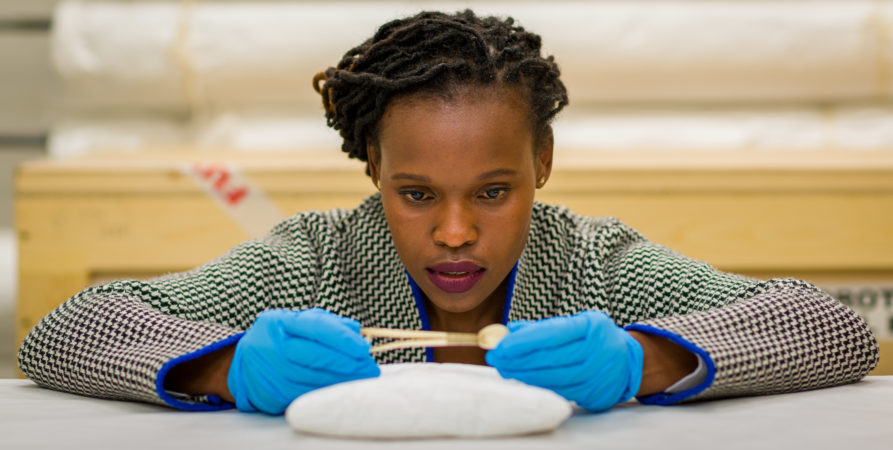Snuff dispensing spoon
Life Story
Tobacco has a long and tangled history on the African continent. Introduced to southern Africa by Portuguese merchants in the sixteenth century, the production, distribution and consumption of tobacco expanded rapidly in the centuries that followed [1]. By the nineteenth century, tobacco was being used widely within indigenous communities across southern Africa – smoked in pipes but also consumed in the form of snuff; a substance produced by grinding up dried tobacco leaves into a fine powder. In this form, tobacco can be rubbed into the gap between the lip and gum or inhaled (‘snuffed’) into the nose to produce a brief high or, in large quantities, an intense hallucination. As consumption of this smokeless form of tobacco grew, it became a popular recreational activity among both men and women. At the same time, snuff became incorporated into the religious practices of many southern African cultures, where it was used to enhance people’s connection to the spiritual realm and to their ancestors.
This spoon, likely carved from the rib bone of an ox or cow, is from the Zulu culture of what is now KwaZulu-Natal province in South Africa. Used for measuring out and ‘snuffing’ tobacco, the spoon’s design is practical, with a long, curved handle and deep bowl. But its design is also aesthetic, with three carefully punched holes at its top and a series of interlocking designs along its stem, burned into the bone with ash and animal fat. Within nineteenth century Zulu culture, decorated spoons such as this were worn by both men and women to express personal style, draw attention to physical attributes and convey social and marital status. Photographs from the period show people adorned in a range of snuff-related items, including ornate transportable containers made of ivory as well as intricately carved dispensing spoons that could double as hairpins or combs [2].
Under colonial rule, tobacco production became a major industry and cigarettes the chief mode of consuming tobacco. As many nations gained their independence, the popularity of snuff and other tobacco products further declined due to health concerns and greater government legislation [3]. In South Africa, however, snuff continues to be used today, especially among older women. Alongside such recreational use, snuff is central to the practice of traditional healers (iSangoma), who use it to sharpen their client’s senses and invoke the healing power of ancestral spirits [4]. The continued significance of snuff was underscored during South Africa’s first Covid-19 national lockdown, when a government ban on non-essential items included snuff, provoking widespread protests among iSangoma, who viewed the ban as an infringement of their religious rights.
Theo Weiss, April 2021
[1] John Giblin and Christopher Spring, South Africa: The Art of a Nation. British Museum Press (2016), 126-140.
[2] Anitra Nettleton, ‘Curiosity and aesthetic delight–the snuff spoon as synecdoche in some nineteenth century collections from Natal and the Zulu Kingdom,’ in Hamilton & Leibhammer, Tribing and Untribing the Archive. University of KwaZulu-Natal Press (2017).
[3] Ucko and Drope Salojee, ‘South Africa’ in Drope, Jeffrey [ed.], Tobacco Control in Africa: People, Politics, and Policies. Anthem Press (2011). 227-246.
[4] Olalekan Ayo-Yusuf, Karl Peltzer and Jane Mufamadi, ‘Traditional healers’ perceptions of smokeless tobacco use and health in the Limpopo Province of South Africa.’ Substance Use & Misuse 41.2 (2006). 211-222.
Exhibitions
'Power Plants: Intoxicants, Stimulants and Narcotics', Sainsbury Centre, UK, 14/09/2024-02/02/2025
Further Reading
Peter De Smet, ‘Traditional Pharmacology and Medicine in Africa: Ethnopharmacological Themes in Sub-Saharan Art Objects and Utensils,’ Journal of Ethnopharmacology 63.1 (1998).
Chris Duvall, ‘Cannabis and Tobacco in Precolonial and Colonial Africa,’ Oxford Research Encyclopaedia of African History. Oxford University Press (2017).
Anitra Nettleton, ‘Of Severed Heads and Snuff Boxes: "Survivance" and Beaded Bodies in the Eastern Cape, 1897–1934,’ African Arts, 48.4 (2015). 22–33.
Provenance
Purchased by Lisa Sainsbury from H. Reisser in 1972 as a gift for Robert Sainsbury.
Donated to the Sainsbury Centre, University of East Anglia in 1973 as part of the original gift.
Not on display
Title/Description: Snuff dispensing spoon
Born: 1900 - 1999
Object Type: spoon
Materials: Bone
Measurements: h. 118 x w. 22 x d. 15 mm
Accession Number: 273
Historic Period: 20th century
Production Place: Africa, South Africa
Cultural Group: Zulu
Credit Line: Donated by Robert and Lisa Sainsbury, 1973
“Heed the call”: Sethembile Msezane explores African knowledge systems past and present
As part of her Sainsbury Centre residency, South African artist Sethembile Msezane took a snuff spoon as inspiration for a fascinating new project
Continue reading











